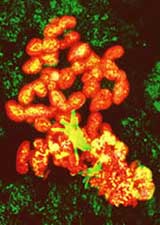Life Sciences and Chemistry
Articles and reports from the Life Sciences and chemistry area deal with applied and basic research into modern biology, chemistry and human medicine.
Valuable information can be found on a range of life sciences fields including bacteriology, biochemistry, bionics, bioinformatics, biophysics, biotechnology, genetics, geobotany, human biology, marine biology, microbiology, molecular biology, cellular biology, zoology, bioinorganic chemistry, microchemistry and environmental chemistry.

Life in a frozen environment – What´s in it for us?
Life on the moons of Jupiter, and a source of healthy polyunsaturated fatty acids and low temperature enzymes that could even make washing powders work at low temperatures: The microbes that live in Antarctic sea ice may hold the answers to a host of everyday applications as well as revealing how life forms might be able to exist on frozen planets. One of those interested in sea ice and the life forms it supports is Dr David Thomas of the University`s School of Ocean Sciences. He is presently the on

An intelligent combination of mathematics and cell biology could spell death to brain tumours
Combining two separate observations of cells in brain tumours could enable doctors to improve the success rate of radiotherapy. Speaking today (23 January) at the Institute of Physics Simulation and Modelling Applied to Medicine conference in London, chemical engineer Dr Norman Kirkby from the University of Surrey will explain how using the correct time intervals between a sequence of low dose radiotherapy sessions could increase the chance of curing brain cancers that tend to resist treatment.

’Eau de dad’ woos women
Genes mean ladies like friends and partners that smell like their father.
Bachelors – ditch the Old Spice and don your prospective father-in-law’s clothes. Women prefer the scent of their dad, a study shows, and may choose their friends and partners accordingly.
Nervous new boyfriends can live or die by the nod of a date’s daunting dad. But Carole Ober and her team at the University of Chicago in Illinois have found a more fundamental fatherly influence: women prefe

Monkey pee, monkey poo
Chimpanzee waste could shed light on the origins and spread of HIV.
Delving into droppings has given AIDS researchers a surprise. Far fewer chimpanzees than they had suspected have SIVcpz, the animal virus most like HIV.
The technique could shed much-needed light on the origins and evolution of the viruses that cause AIDS. “It’s a non-invasive means to study the wild relative of HIV in its natural environment,” says Beatrice Hahn, of the University of Alabama in Birmingham,

Life, as it was in the beginning?
A new type of Earth ecosystem could be found on other planets.
Scientists have found a community of microbes unlike anything else on Earth. Conditions in this ecosystem could mimic those on Earth when life began, and might exist elsewhere in today’s Solar System.
Home to the microbes is a hot spring 200 metres beneath the US state of Idaho. Their lives owe nothing to the Sun. They generate energy by combining hydrogen from rocks with carbon dioxide, releasing methane as a by

Uprooting and replanting the tree of life
A new theory on the evolution of ancient microbes is set to challenge widespread scientific views of early life on earth and could overturn previous interpretations of the huge bank of molecular taxonomic data that has been built up in recent years, according to research published today in the International Journal of Systematic and Evolutionary Microbiology.
“I`ve reinterpreted fossil records to show that eukaryotes, which includes plants, animals and fungi, are only half as old as previous